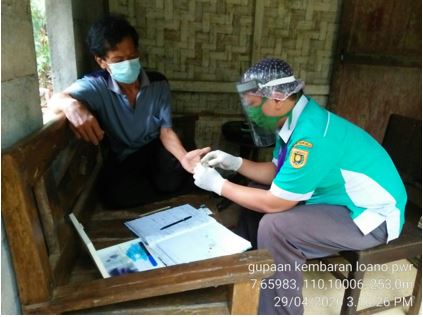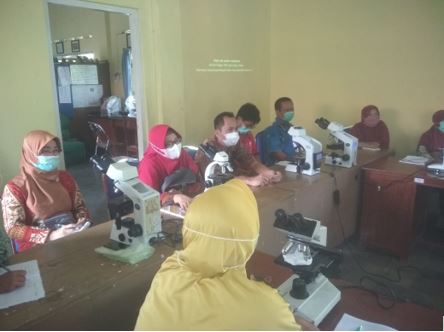In a late afternoon in Banyuasin Loano village, Purworejo, Central Java, people are resting at home after a long day of work in the fields. Supriyanto, a village malaria worker, is going from house-to-house to inspect mosquito breeding grounds and check if anyone in the village has malaria symptoms such as fever and headache.
Village malaria workers like Supriyanto are key players in the strategy to fight malaria, launched by the Purworejo District Health Office (DHO) in 2016. They are leading malaria case finding and surveillance at the community level, enabling rapid detection, assisting treatment, and preventing the malaria parasite from spreading.

Photo caption: Supriyanto, a village malaria worker, is obtaining a finger-prick blood sample for the malaria rapid diagnostic test. During the COVID-19 pandemic, health workers and village malaria workers wear a mask, face shield, and gloves as part of the health protocols to prevent contracting COVID-19. Photo credit: Widonarto/Purworejo District Health Office
Previously, village malaria workers' role was limited to malaria sensitisation, and there was little incentive for their work. Recognising the importance of combating malaria at the village level, the Purworejo DHO trained more village malaria workers and doubled their stipend to IDR 1 million per month. This is in line with WHO recommendations to invest in community and health care workers as part of the comprehensive strategy to control malaria. The Ministry of Health (MoH) had adopted this and supported the role of village malaria worker (Juru Malaria Kampung) through the Ministerial Decree No. 41/2018 on early detection and treatment of malaria in special regions by malaria cadres.
Since Purworejo was reported free from indigenous (contracted locally) malaria case in 2019, village malaria workers' role in migration surveillance became even more critical. They need to screen people visiting Purworejo to ensure they do not carry malaria from outside and reintroduce it into the village.
Village leaders will inform village malaria workers when there are people returning from malaria-endemic areas, who will then screen each person using the rapid diagnostic test. If the person is tested positive, a village malaria worker will refer them to the community health centre for treatment. Within three days, village malaria workers and staff of the community health centre (puskesmas) will conduct mass blood sample to check if anyone else in the village has been infected.
"We must make sure all malaria cases are reported and treated quickly," said Supriyanto, who has been a village malaria worker since 2013. "If the person from a malaria-endemic area arrives at night, we still need to get him or her tested and make sure they sleep under an insecticide-treated mosquito net to stop malaria from spreading. We must be vigilant; we must catch the malaria case before mosquitoes catch them."
Each month, village malaria workers gather at the Malaria Centre, a coordination centre for the malaria control programme run by Purworejo DHO, to get refresher training delivered by the Purworejo DHO, the Environmental Health and Disease Control Center (BBTKLPP), and the community health centre (puskesmas). They are trained to identify mosquitoes for vector surveillance, diagnose malaria symptoms, ensure quick notification of cases, understand the latest malaria treatments, and ensure patients' treatment adherence.

Caption: Each month, village malaria workers gather at the Malaria Centre, a coordination centre for malaria control programme run by Purworejo DHO, to get a refresher training on vector surveillance, case identification and reporting. Photo credit: Widonarto/Purworejo DHO
According to Widonarto, a Purworejo DHO staff who has been in charge of the malaria control programme since 2007, village malaria workers are now much more skilful and proactive in identifying and isolating cases. Apart from their day-to-day work, village leaders actively involved village malaria workers during a series of consultative meetings to develop village regulations on malaria migration surveillance.
"Village malaria workers show how trained and empowered community members can significantly contribute to malaria control,” said Widonarto. “They are very dedicated and on standby 24 hours to respond to any malaria cases”, said Widonarto.
One night, Supriyanto, the village malaria worker, received a phone call from a neighbour whose wife was having a fever. Supriyanto took off at 10 PM on a motorbike carrying his malaria kit. He checked the person's body temperature and administered the malaria rapid diagnostic test. It was positive. Supriyanto quickly consulted the doctor at the Banyuasin community health centre (puskesmas), and the person was admitted for malaria treatment. The following day, Supriyanto and the staff of the community health centre (puskesmas) administered a mass blood survey to around 85% of people in the village to check if the malaria parasites infected anyone else. People who tested positive were referred to the community health centre for treatment. After about one week of treatment, they had all recovered.
"Being a village malaria worker makes me proud because all of my family members suffered from malaria when I was a child," recalled Supriyanto. "I am grateful to have a job where I can give a little contribution to help relieve the suffering of others. I hope we can continue to be vigilant and ensure Purworejo is free from malaria 100%!"
Since the onset of COVID 19, health care workers and village malaria workers have been implementing extra public health and social measures to curb the spread of COVID 19. They wear appropriate personal protective equipment when conducting malaria testing and providing treatment. House-to-house case finding and surveillance are being conducted while maintaining physical distancing.
The results of three years of strict migration surveillance and empowering village malaria workers have been impressive. Back in 2015, Purworejo DHO recorded around 1400 malaria cases in one year. Starting in 2018, the number of malaria cases has dropped to 189 indigenous and seven imported cases. In 2019, the district recorded 0 indigenous and 26 imported cases, and in 2020 only seven imported cases were recorded.
To sustain this success, malaria elimination efforts must continue through robust surveillance, provision of long-lasting insecticidal nets and repellents, quality diagnostics, availability of antimalarial drugs, and trained village malaria workers. The Purworejo District government is committed to mobilising funds and involving cross-sectoral departments to accelerate malaria elimination, as stipulated in the Purworejo Bupati Decree No. 17 enacted in 2019.
